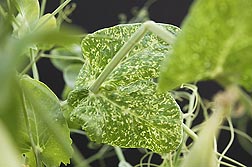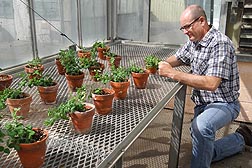Markers Highlight the Way to Disease Resistance in Peas
|
|
Seed companies now have a leg up in breeding new pea varieties with resistance to one of the legume crop’s most costly viral scourges, the Pea enation mosaic virus (PEMV). Agricultural Research Service and university scientists have identified regions of the crop’s DNA that can mark the location of a gene conferring resistance to the virus.
Using molecular procedures to detect the markers, plant breeders can rapidly identify which plant varieties have inherited the gene for resistance. Conventional methods for determining which plants have resistance genes involve growing the plants to maturity in a greenhouse or field plot, exposing them to the virus, and monitoring them for a month or more for disease symptoms.
With the marker-assisted selection method, plant breeders can determine whether individual plants have resistance in just a few hours, using samples of DNA from the mature plants, seedlings, or test-tube-grown material known as “callus.” Other benefits of marker-assisted selection include savings on operational costs, resources, and labor to develop new varieties from selected plants.
PEMV attacks pea crops worldwide, with disease symptoms including stunted growth, translucent “windows” on leaves, blisterlike lesions, deformed pods, and reduced yield. In the United States, the disease is especially costly to pea growers in eastern Washington and northern Idaho, with epidemics occurring there about every 8 years and inflicting losses of up to 100 percent.
|
|
Conventional controls include spraying pea crops with insecticides to kill or repel aphids, which transmit PEMV as they feed on the plants. However, “genetic resistance to PEMV is the most cost-effective and environmentally safe means of managing this virus,” says plant pathologist Lyndon Porter, in ARS’s Vegetable and Forage Crops Production Research Unit in Prosser, Washington. Currently, “there are no known dry pea cultivars grown commercially in the United States that are resistant to PEMV,” he adds.
To fill that order, Porter teamed with several experts in pulse crop breeding and legume genetics—namely Kevin McPhee and Shalu Jain at North Dakota State University-Fargo, Norman Weeden at Montana State University-Bozeman, and Sanford Eigenbrode at the University of Idaho-Moscow.
From field and greenhouse evaluations of 393 plants derived from crosses of susceptible and resistant pea cultivars, the team mapped PEMV resistance to a single gene, previously dubbed En, nestled between two molecular markers, CNGC and tRNAMet2, on the third of pea’s seven chromosome pairs.
Tests to validate the markers showed they are 99.4 percent accurate in identifying pea plants with resistance to PEMV. Details were published in the November-December 2013 issue of Crop Science.
Ag-Biotech Inc., in San Juan Bautista, California, has converted and commercialized the markers into a breeder-friendly SNP-based marker for high-throughput marker-assisted selection. A New Zealand firm and its U.S. affiliate are now using the SNP-based marker in their pea-improvement programs.
“We have already made crosses and screened second-generation populations for resistance using these markers,” reports Adrian Russell, managing director of Plant Research (NZ) Limited. “The markers will have interest wherever this virus is a problem, so the benefits will not just be seen in the United States,” he predicts.—By Jan Suszkiw, Agricultural Research Service Information Staff.
This research is part of Crop Protection and Quarantine, an ARS national program (#304) described at www.nps.ars.usda.gov.
Lyndon Porter is in the USDA-ARS Vegetable and Forage Crops Production Research Unit, 24106 North Bunn Rd., Prosser, WA 99350; (509) 786-9237.
"Markers Highlight the Way to Disease Resistance in Peas" was published in the November/December 2014 issue of Agricultural Research magazine.








